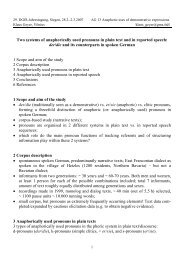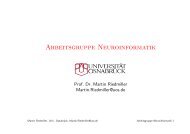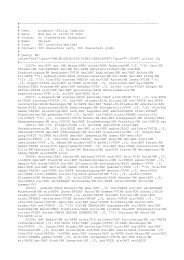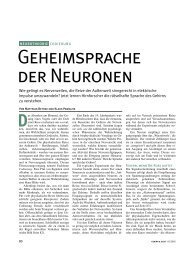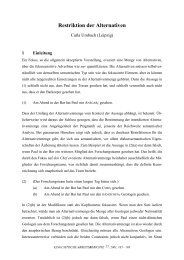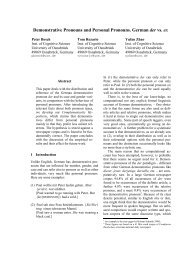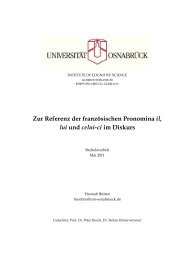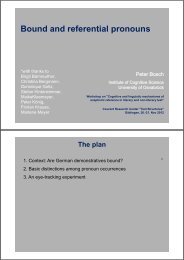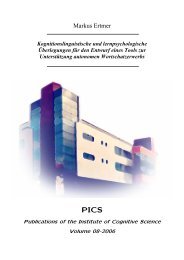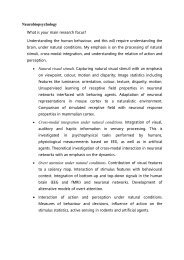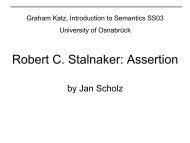- Page 1: Sinn & Bedeutung Proceedings of the
- Page 4 and 5: ISSN: 1610-5389 Series title: Publi
- Page 7 and 8: Program Sunday, October 07 18.30 -
- Page 9: Wedneday, October 10 09.45 - 10.30
- Page 12 and 13: Peter Krause PRESUPPOSITION JUSTIFI
- Page 14 and 15: The contrast between (2) and (3) is
- Page 16 and 17: strings has a meaning roughly equiv
- Page 18 and 19: 2.4 Coordinate parts with number ma
- Page 20 and 21: We find that sgan-ei ve-tat-ei aluf
- Page 22 and 23: examples. Rather, the contrast is a
- Page 24 and 25: Indeed, if the deletion rule has no
- Page 26 and 27: (49) schei- en natuurkunde ‘chemi
- Page 29 and 30: NON-DYNAMIC ANALYSES OF ANAPHORIC P
- Page 31 and 32: (5) a. Exactly one boy left school
- Page 33 and 34: exploited. That is, one would expec
- Page 35 and 36: (17) At the Seattle demonstration,
- Page 37 and 38: (24) a. John is politically naive a
- Page 39 and 40: We get an account of cases such as
- Page 41: 5 Conclusion There is quite strong
- Page 45 and 46: 〈1〉 quantifiers? Now one may tr
- Page 47 and 48: Proof. Let F n be reducible so that
- Page 49 and 50: ZU EINER SEMANTISCHEN KLASSIFIKATIO
- Page 51 and 52: 2 Drei semantische Kriterien für d
- Page 53 and 54: sich dabei nur um eine exemplarisch
- Page 55 and 56: (9) Verben des Außer-Erscheinung-T
- Page 57 and 58: Zustandswechsel ausreicht, um das s
- Page 59 and 60: 3.3 Abstraktes In- oder Außer-Ersc
- Page 61 and 62: Das Verb drückt aus, dass die Phas
- Page 63 and 64: 4 Fazit In diesen Beitrag ist der V
- Page 65 and 66: SEMANTIC CHANGE IN GRAMMATICALIZATI
- Page 67 and 68: “Was erst neu und selten war, wir
- Page 69 and 70: (19) I am going to like Bill (20) I
- Page 71 and 72: show the composition (I will leave
- Page 73 and 74: (34) can be composed from the liter
- Page 75 and 76: them have the property in the nucle
- Page 77 and 78: hard to offer a plausible measure f
- Page 79: Meillet, Antoine. 1912. “L’évo
- Page 82 and 83: model. We therefore need a color ci
- Page 84 and 85: As typical features of verb meaning
- Page 86 and 87: Figure 5: Modelling time in ‘topp
- Page 88 and 89: and this would make sense intuitive
- Page 90 and 91: ‘to climb over the wall’ b. die
- Page 92 and 93:
d. Das Flugzeug sank tiefer. (the p
- Page 94 and 95:
We can sum up our result in the fol
- Page 97 and 98:
ELLIPSIS AND THE STRUCTURE OF DISCO
- Page 99 and 100:
(4) People convinced John to play t
- Page 101 and 102:
Agnes arrived S1 S2 AFTER . it’s
- Page 103 and 104:
4. *(JJT) [John revised John’s pa
- Page 105 and 106:
we look at cases which involve impl
- Page 107 and 108:
First, S2 and S3 match semantically
- Page 109 and 110:
using another set of propositions (
- Page 111 and 112:
THE USE OF MULTILAYERED EXTENDED SE
- Page 113 and 114:
• Interoperability. The represent
- Page 115 and 116:
Concrete objects [co] Discrete obje
- Page 117 and 118:
K-TYPE: • [K-TYPE cat] - categori
- Page 119 and 120:
and the corresponding property at t
- Page 121 and 122:
• Graphical manipulation and visu
- Page 123 and 124:
4.3 LIA - The Workbench for the Com
- Page 125:
Appendix A. Overview of Selected Re
- Page 128 and 129:
woman in (6), which has narrow scop
- Page 130 and 131:
2.3 Partitive-specificity Milsark (
- Page 132 and 133:
Higginbotham (1987, 64) produces th
- Page 134 and 135:
Dede (1986, 158) observes that dire
- Page 136 and 137:
The following example confirms the
- Page 138 and 139:
indefinite NP can get wide or narro
- Page 140 and 141:
variables or discourse referents. O
- Page 142 and 143:
Bibliography Dede, Müserref 1986.
- Page 145 and 146:
AGENTIVE SELBST IN GERMAN* Daniel H
- Page 147 and 148:
No such marked structure results fr
- Page 149 and 150:
Contrasts as the ones in (7) and (8
- Page 151 and 152:
A: Nein, er hat es geschenkt bekomm
- Page 153 and 154:
This list is reminiscent of the lis
- Page 155 and 156:
ately above VP assigns or, in Minim
- Page 157 and 158:
What we see is that the denotation
- Page 159 and 160:
other modes of involvement. It shou
- Page 161 and 162:
Gülzow, Insa (2001) ‘Der Ausdruc
- Page 163 and 164:
ISSUES AND AWARENESS Joris Hulstijn
- Page 165 and 166:
Finally, for task oriented dialogue
- Page 167 and 168:
The relation ¨ represents an infor
- Page 169 and 170:
An information state σ is said to
- Page 171 and 172:
3.5 Explicit belief Following Fagin
- Page 173 and 174:
¤ ¥ ¢ ¤ ¥ ¢ ¤ ¥ ¢ w¡ ¥
- Page 175 and 176:
(5) Which bachelors are unmarried?
- Page 177 and 178:
A: (looking in the programme) Agnes
- Page 179:
Ginzburg, Jonathan. 1995. Resolving
- Page 182 and 183:
elieve, think, understand and know
- Page 184 and 185:
some of the most interesting recent
- Page 186 and 187:
(16) Jones1 believes 2 [his1 pants
- Page 188 and 189:
In other words, (21a) is true only
- Page 190 and 191:
Von Stechow suggested that tenses b
- Page 192 and 193:
elieve and the structure would be u
- Page 194 and 195:
(45) Fritz expects Arnim to laugh.
- Page 196 and 197:
Ogihara, Toshiyuki (1989). Temporal
- Page 198 and 199:
I sketch my analysis of CSAs: CSAs
- Page 200 and 201:
3.1 CSAs as Construct-State Element
- Page 202 and 203:
. *ha- na’ara [ha- yefat eynayim]
- Page 204 and 205:
d”’. *na’ara [yefat ha- eynay
- Page 206 and 207:
. ha- na’ara [Se eyne -ha yafot]
- Page 208 and 209:
5.1 A Syntactic Alternative Inalien
- Page 210 and 211:
Further consequences of this propos
- Page 212 and 213:
complement to inalienable nouns. On
- Page 214 and 215:
e. In der Nacht hatte es unglaublic
- Page 216 and 217:
differenziertere Struktur erhält:
- Page 218 and 219:
matisieren: (iiia) Nicht-A A 206 GP
- Page 220 and 221:
(va) (vb) A aNicht- GPA GPA Nicht-A
- Page 222 and 223:
(14) a. Die endlos sich dehnende St
- Page 224 and 225:
'irreal'. Heute handelt es sich bei
- Page 226 and 227:
daß an dieser Tatsache nicht der g
- Page 229 and 230:
INDIVIDUALS AND PREDICATION -ANEURO
- Page 231 and 232:
In the light of such reflections wh
- Page 233 and 234:
(such as, for instance that of bein
- Page 235 and 236:
tion in working memory. In fact, we
- Page 237 and 238:
perceptual concepts which two speak
- Page 239 and 240:
the street yesterday almost certain
- Page 241 and 242:
in a region r can be computed from
- Page 243:
Wennekers, T. and Palm, G. (1997).
- Page 246 and 247:
(7) John and Mary got married. (8)
- Page 248 and 249:
4 Sheafification We may consider a
- Page 250 and 251:
(24) A table or chair was in this r
- Page 253 and 254:
PRESUPPOSITION JUSTIFICATION BY ABD
- Page 255 and 256:
(3) The king of Burundi is bald. pr
- Page 257 and 258:
(12) a. If few mountaineers know th
- Page 259 and 260:
econstructed is such that the presu
- Page 261 and 262:
2. bindings in H2 and H3 The first
- Page 263 and 264:
The following example is a variatio
- Page 265 and 266:
4 Conclusion x0 plane(x0) x0 ρ X n
- Page 267 and 268:
IS THE GERMAN PERFEKT A PERFECT PER
- Page 269 and 270:
time; unlike events, states possess
- Page 271 and 272:
espective aspect. Perfect aspect, h
- Page 273 and 274:
Construction P is known as stative
- Page 275 and 276:
3 Analyses of the Perfekt 3.1 Forme
- Page 277 and 278:
may be more AT specifications. If P
- Page 279 and 280:
context is not like that. At this p
- Page 281 and 282:
argument of tense, time adverbials
- Page 283 and 284:
. Er hat noch1 den Arm verbunden. (
- Page 285:
Litvinov, Viktor P., and Vladimir P
- Page 288 and 289:
This simple approach is, however, p
- Page 290 and 291:
. [the d: my bicycle was d-expensiv
- Page 292 and 293:
of a maximality operation does not
- Page 294 and 295:
necessity like must, should, etc. h
- Page 296 and 297:
(30) 8w’,w” 2 W and for any A 2
- Page 298 and 299:
(41) 8w,w’,w*:w’ w w” iffw’
- Page 301 and 302:
SIGNALLING GAMES SELECT HORN STRATE
- Page 303 and 304:
suggests that the murderer performe
- Page 305 and 306:
Parikh wants to account for the fac
- Page 307 and 308:
Having fixed the probability and ut
- Page 309 and 310:
t t ′ S1 f f S2 f ′ f f f ′ H
- Page 311 and 312:
U ∗ 2(t,S,R) = ∑ t ′ ∈St P(
- Page 313 and 314:
an explanation of it in terms of th
- Page 315 and 316:
probabilities that the receiver ass
- Page 317 and 318:
Notice that the expected payoff of
- Page 319 and 320:
Our first trial to characterize Hor
- Page 321 and 322:
[5] Cho, I. & D. Kreps (1987), ‘S
- Page 323 and 324:
PURE MANNER ADVERBS REVISITED Marti
- Page 325 and 326:
well as semantically. Thus, (1-2) h
- Page 327 and 328:
2.1 Problems for the semantic chara
- Page 329 and 330:
(18) a. *Kim loudly had gone home t
- Page 331 and 332:
4 A formal Account of PMA A formal
- Page 333 and 334:
4.3 The derivation of the readings
- Page 335:
References Bartsch, R. (1972). Adve
- Page 338 and 339:
A similar effect of sentence negati
- Page 340 and 341:
descriptive content of the declarat
- Page 342 and 343:
explicitly. For instance, the same
- Page 344 and 345:
The argument DP meets the criterion
- Page 346 and 347:
With respect to compositionality, t
- Page 348 and 349:
≡ λℜ λx λe [ℜ (λy [(¬)[[
- Page 350 and 351:
λQ λxi [∃e [Q (e, xi)]]] PosP [
- Page 352 and 353:
(b) MammalsTopic [are WHALES]Focus
- Page 354:
PICS Publications of the Institute



